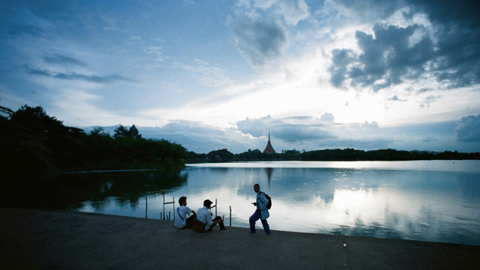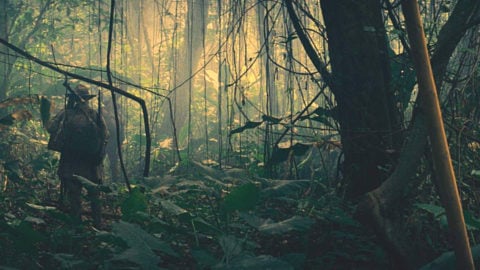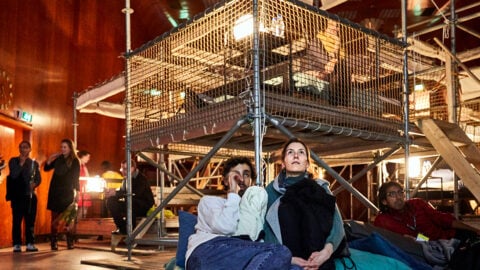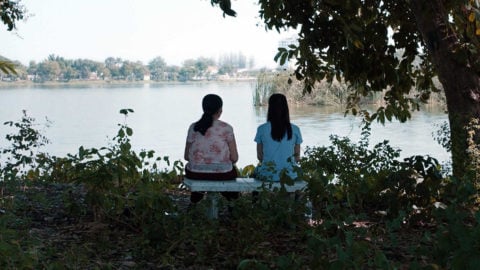Queer & Now & Then: 2004
In this biweekly column, Michael Koresky looks back through a century of cinema for traces of queerness, whether in plain sight or under the surface. Read the introductory essay.

Images from Tropical Malady (Apichatpong Weerasethakul, 2004)
Love is transformative in Apichatpong Weerasethakul’s Tropical Malady. Provocatively cleaved in two, it’s the rare film to have felt radical and exciting upon its release and still feel like a monumental work 15 years later. Even considering the trio of features the Thai director has made since, each of them epochal, rigorous, and structurally daring in its own way—Syndromes and a Century, Uncle Boonmee Who Can Recall His Past Lives, and Cemetery of Splendor—this unorthodox 2004 romance still might be his most cleanly conceived statement of authorial intent. Grafting together a realist tale of gay male courtship and a mythic fable of primal desire, Tropical Malady announced one of our most potent cinematic voices, a director whose influence over the narrative, structure, and visual language of contemporary cinema will likely only be measurable many years from now.
Apichatpong’s queerness is central to that influence, not incidental. The radical nature of Tropical Malady is not only in its formal audacity but also in the way it uses a gay love story to evoke primal truths about human desire. In most Western films, this would indicate a specious kind of love-is-love “universalism”—don’t forget that Brokeback Mountain was just one year away—but in the hands of an idiosyncratic artist like Apichatpong, no cultural or sexual specificity is diluted. Though he had already made two formally unclassifiable films—the exquisite-corpse-style Mysterious Object at Noon and the freeform, up-a-lazy-river Blissfully Yours (which, though an ostensibly heterosexual idyll, memorably features a languorous close-up of a flaccid cock being aroused to erection)—Tropical Malady won a Jury Prize at Cannes and thus could be considered, for many viewers, his true international breakthrough and a statement of intent. Apichatpong is here upending so many expectations and rules of what narrative moviemaking is supposed to be and do—in format, in structure, in character, in texture, in sexual expression—that it becomes as regenerative as the form of transubstantiation that happens halfway through the film, when our two contemporary male protagonists suddenly and inexplicably become the main figures in a Buddhist-tinged fairy tale, a shift in focus and style and mood that carries the viewer to a different level of cinematic consciousness.
Speaking of transformations: I’d be neglectful to not describe my connection and response to Tropical Malady as a deeply personal one. Its U.S. premiere came during a period of time that was for me marked by both aesthetic and sexual awakenings. When it showed at the New York Film Festival in October 2004, I had only recently come out of the closet, and those years of post-college self-discovery are inextricably linked in my mind with simultaneous, crucial feelings of artistic exploration. In my mind I have a difficult time untangling my immediate and emotional reaction to Tropical Malady from who I was then, or who I was trying to become. During these years, I was immersing myself in New York cinephile culture for the first time, and funneling my feelings and revelations about all different kinds of cinematic expression through Reverse Shot, a film journal I had recently started with some equally movie-besotted friends I had met while on these travels. At the same time, I was making the frightening and thrilling decision to start dating men, an experience that colored my reaction to everything I was seeing, so that films as disparate as Before Sunset, Elephant, Kill Bill, Primer, She Hate Me, and Twentynine Palms became internalized reflections of my current emotional state. It was different with Tropical Malady, which was, to my eyes, a clearly brilliant and unusual work of art that was engaging overtly with the kind of tentative gay desire I was feeling.
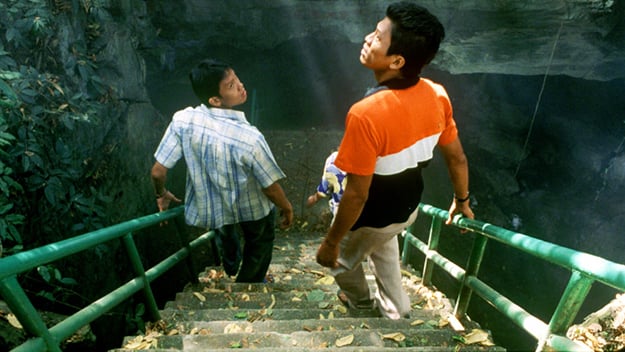
Both halves of the film are crafted with a nonchalant style one might call beguiling, but the naturalistic first section of Tropical Malady, which coasts on the delicate wavelengths of two young people falling gradually in love, still holds for me a particular enchantment. In delicately charting the evolving romance between forest patrol soldier Keng (Banlop Lomnoi) and factory worker Tong (Sakda Kaewbuadee), Apichatpong locates a strain of intense, stylized earnestness that somehow never feels at odds with the unforced, observational realism with which he films it. There’s a halting, tentative nature to their courtship. Soon after they’ve met in the rural village where Keng has been temporarily stationed, they meet each other by chance in passing vehicles on the bustling street of the local town. Here, away from the hush of the countryside, Tong teases Keng, telling him, “I’ve forgotten your name” before they smile and their vehicles drive off in different directions. Yet they keep coming back together, moving ever closer to one another. There’s a gorgeous simplicity to their gestures. Throughout, Tong’s attempts at mating rituals are innocent, almost childlike, showing off his double-jointed fingers and wiggling ears. Keng is more direct: as the two sit on Tong’s family porch in the rain, the camera patiently watching from behind, Keng gives Tong a mix tape featuring the Thai rock band Clash. “I’d hate to die without having loved,” says Keng, which elicits a giggling response (“You’re so sappy”) from Tong. Later, Tong’s aunt finds a note from Keng tucked into Tong’s pants pocket (“I like you very much”), which leads not to outrage but a kind of benevolent encouragement.
While there’s no indication of overt homophobia in the village and local town, Tong and Keng’s burgeoning love is necessarily kept on the margins, and there are tossed-off inferences to the hopeful lovers’ desires to keep things discreet, especially Tong. However lovely and benign it appears, Apichatpong is careful to keep their love from seeming too paradisiacal; their attraction defiantly blooms in a world defined by macho ritual—as exemplified by Keng’s military buddies—and heteronormative standards, as when a shoe salesman presumptively encourages Tong to buy a pair that will be “perfect for impressing girls.” For all the men’s sweet, earnest smiles and playful quirks—during a movie theater date, a mischievous Keng puts his hand on Tong’s thigh, who crosses his other leg and traps Keng’s hand in a childlike clinch—there is the recurring hint of something darker. “What are these cuts?” Keng asks when looking at Tong’s arm. The moment is quickly elided by Tong, even though its memory hangs in the air.
“When I gave you the Clash tape, I forgot to give you my heart,” Keng tells Tong in one of the most richly saccharine lines of dialogue in any movie so far this century. He then gives it to him, touching him in a brief moment of emotional, physical, and spiritual transference that feels like a direct appeal between moony-eyed, pop-loving teenagers. Yet it goes deeper: rather than naïve, their words are like codes that mask something more purely carnal. Soon before the film dramatically shifts gears, Keng and Tong bid an evening’s farewell on a dark street; this time, words fail them and they give over to a more primal, animalistic expression of affection. Keng grabs Tong’s hand and begins to sniff his fingers and knuckles, as though trying to absorb its essence; Tong returns the gesture by grabbing Keng’s forearm and licking his hand while looking into his eyes. After this visceral, erotic shared moment, Tong walks off, fading away into the shadow of the dark street.
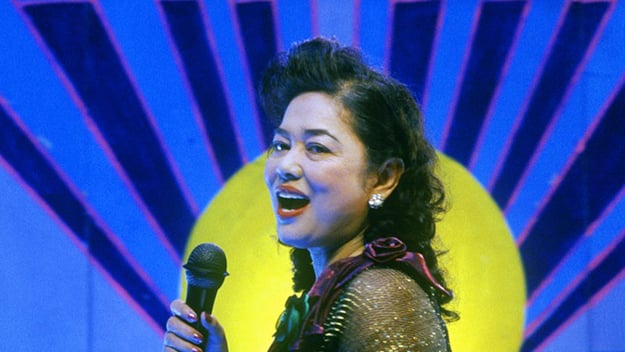
We will not see them in the same space at the same time again. In a short, mid-film passage that functions as a kind of interlude, Tong is shown tossing in his bed in the morning light, an expanse of nature visible outside his room’s window. After a sharp cut, Keng, dressed in his fatigues, enters the now empty room and sits on his bed, his hand rubbing across the sheets. We hear offscreen dialogue emanating from outside: livestock has gone missing, paw prints have been found, and the villagers are fearful. Keng finds a photo album by Tong’s bed, and begins to flip through it, stopping on an image of Tong with another man. The screen flares, and then goes blank. Fifteen seconds of complete blackness, during which time, I recall, the original NYFF audience began to grow inquisitive and restless, craning their necks back to the projection booth to see if something had gone wrong. Of course not: the screen slowly fades back in to a drawing of a tiger, perhaps a child’s illustration or a cave painting. An entirely new narrative, titled “The Tiger’s Path,” begins, recasting Keng and Tong as mythic variations on themselves. Keng has been tasked with hunting the anthropomorphized man-beast, embodied by a naked, tattooed Tong, who has been terrorizing the villagers.
In the second half of Tropical Malady, the pursuit of love seems to be reduced to a primal essence of predator and prey, although the roles are at one point provocatively reversed. As their silent journey wears on, the spirit beast becomes infatuated with the soldier, turning the tables on who’s the hunter and who’s being hunted. Apichatpong releases our emotionally reticent heroes from their human limitations, sending them into deep thickets of jungle. Keng’s soldier is often barely illuminated by moonlight, surrounded by thick vines and trees, as he searches through the night. The remainder of the film is almost entirely wordless, except for the subtitled chirps of the small animals that populate the magical forest. “You are his prey and his companion,” a chatty monkey calls out to Keng. “Kill him or let him devour you and enter his world.”
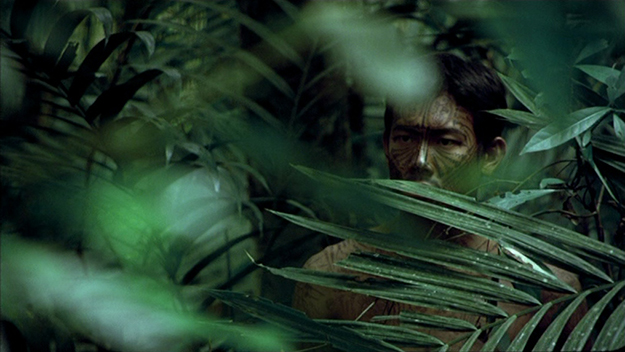
For all of the bewitching imagery in Apichatpong’s cinema, perhaps nothing he has made comes close to the meditative, transporting nighttime beauty of the final half hour of Tropical Malady: the ghost of a killed ox rising in the night like a storybook specter, a bounteous tree lit from within by fireflies like paper lanterns, and, finally, the unforgettable composition of the tiger in silhouette, perched on a tree branch high above the soldier. Their faces in separate close-ups: the tiger staring straight into camera, aglow in night vision; the soldier on the ground, from a high angle, neck craned. A tear streams down actor Banlop Lomnoi’s face. He looks, all at once, afraid, ecstatic, and amorous. The image is then recast as a Buddhist cave painting, the human on its knees, hands clasped as it gazes up at the tiger. The illustration indicates that the communion between man and beast achieves not only love but also enlightenment.
In 2005, I had the pleasure of interviewing Apichatpong for Reverse Shot over the phone, an opportunity that excited my young and impressionable self. Because of the languorous real-time images of some of his films and the sense of the casual capturing of reality, I asked him whether he sees himself partly as a documentary filmmaker. His response stayed with me:
“I don’t believe in reality in film. For me there’s no reality, because filmmaking is a very affected medium. So even what you call documentary is not representing the truth, because it’s too subjective and you can’t create something like a film to just look at certain things. So I think the films I make are just my expression of my life, but it doesn’t necessarily mean the truth, or a kind of assimilation of appreciation of being alive.”
Tropical Malady is clearly as “unreal” as a movie can be: mythic, supernatural, formally experimental. Yet for me, it was conveying something that couldn’t feel more real. Even the most fanciful film can speak to our specific realities. At the conclusion of Apichatpong’s marvelous film, as the tiger and man communicate silently, and as each locks eyes with the camera, and with us viewers watching the screen, I experienced a rupture. In that moment, I felt—and still feel—the thrill of cinema, the power of desire, and the exhilarating fear of change and transformation.
Michael Koresky is a writer, editor, and filmmaker in Brooklyn. He is cofounder and editor of the online film magazine Reverse Shot, a publication of Museum of the Moving Image; a regular contributor to the Criterion Collection and Film Comment, where he writes the biweekly column Queer and Now and Then; and the author of Terence Davies, published by University of Illinois Press, 2014.



